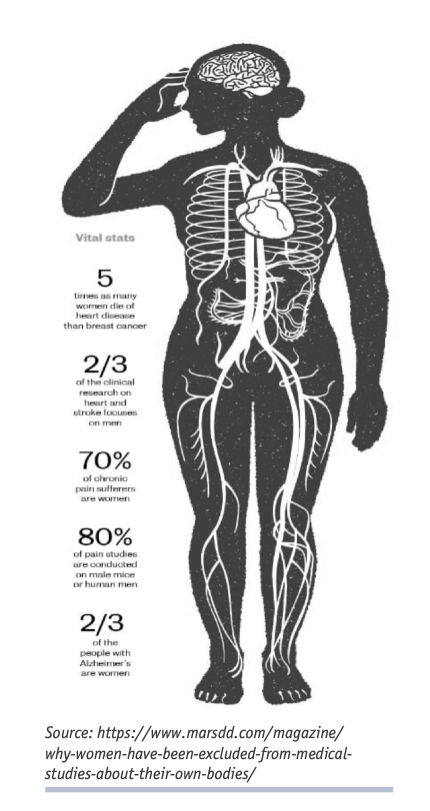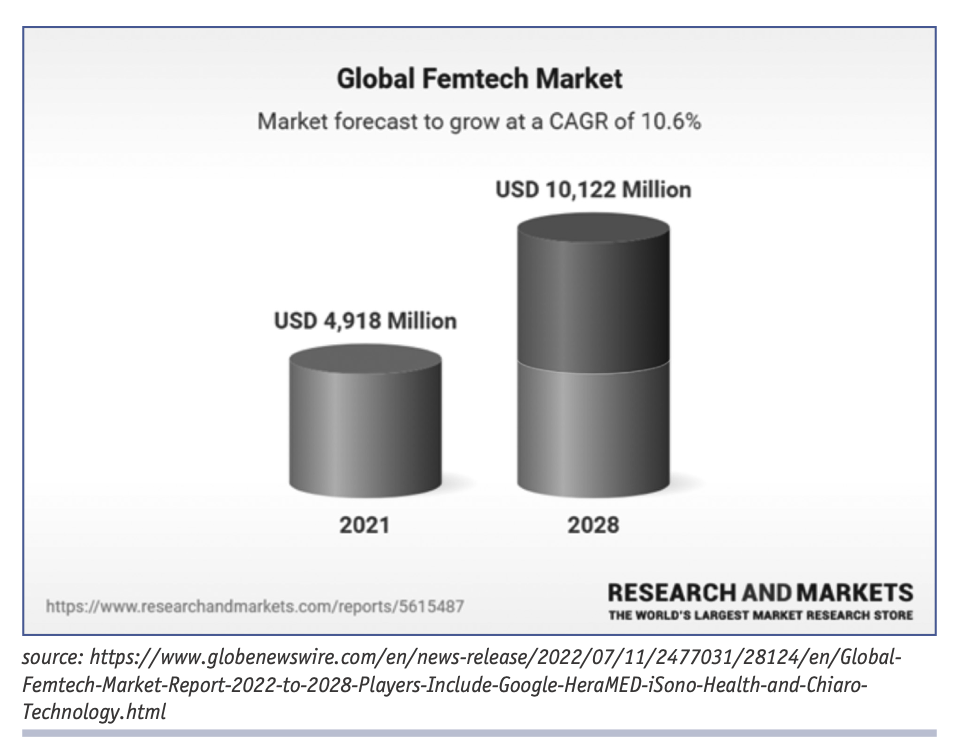FemTech–Investing In Women’s Health
In 1966, James Brown recorded “It’s a Man’s, Man’s, Man’s, World”. Perhaps the repetition was meant to settle any question about who was boss. Gender equity has measurably improved since then—at least in some quarters. One area where the gap remains stubbornly persistent is in women’s healthcare, where blind spots remain. FemTech is the burgeoning field of technology-enabled products and services to offer solutions to female-specific conditions. Not only could FemTech lead to better health outcomes for women, but it also presents opportunities for investors as the total addressable market is half the world’s population.
Rethinking The X-Y Medical Template
A study conducted by the University of Toronto Temerty Faculty of Medicine surveyed 1.3 million adult patients in Ontario over a 12-year period and focused on 21 different types of surgery. They found women patients were 15 per cent more likely to die or experience complications, had an 11 per cent increased likelihood of re-admission, and a 32 per cent greater chance of dying 30 days post-procedure than a comparable male patient when the woman was operated on by a male surgeon.
Gender bias—whether conscious or not—was likely a factor in the poorer outcomes for women, but another contributing factor could be the deficit of scientific data on women’s responses to various medical treatments since most medical research is conducted on male animal and human subjects. Researchers’ rationale for excluding females from testing is that hormone fluctuations and pregnancy may affect outcomes. This bias is slowly shifting, but existing drug dosage, diagnostic, and treatment protocols are still based on the male model, sometimes comically so. In 1986, a study conducted by Rockefeller University on how obesity affected breast and uterine cancer was conducted solely on male subjects!
When considering the “majors”, such as heart attacks, strokes, diabetes, and concussions, they present differently in men and women. Because of this, often, women’s symptoms are overlooked, and they do not receive aggressive diagnostic tests and timely care. For example, women are more susceptible to concussions than men, and elderly women are more likely to die from them. One in eight Canadian women is estimated to suffer from an unrecognized brain injury related to intimate partner violence (IPV), or 4,500 concussed women for every one concussed NHL player. Being repeatedly assaulted on the face, head, and neck or strangled can lead to chronic traumatic encephalopathy and increase the likelihood of dementia or Alzheimer’s, as well as other cognitive and behavioural issues. Yet it is research on the impact of brain injuries on professional male athletes that receive millions of funding each year. FemTech seeks to address some of this imbalance.

FemTech: Opportunities And Challenges
The promise of FemTech is to improve women’s health and to create positive social changes through technology-related products and services. FemTech companies are typically led by women founders and are more likely to engage female inventors, researchers, and investors. Studies show male inventors are more likely to solve male-oriented problems, whereas women-led teams solve for both women and men.
Femtech-focused companies are far from a niche market. Women make 80 per cent of consumer healthcare decisions (US$500 billion), yet FemTech companies have received only three per cent of all digital health funding since 2011. Globally, only four per cent of all medical research spend is directed toward women. Beyond breast cancer, female health has received only one per cent of pharmaceutical research monies (2020), and only two per cent of medical tech funding goes to non-cancer-related women’s health problems. As a point of comparison, in 2019, FemTech companies received US$592 million in venture capital investment; the same year, Uber raised US$8.1 billion in an IPO.
However, FemTech’s fortunes are improving, in 2021 the sector attracted US$2.4 billion in seed money and is expected to generate US$1.1 billion in revenue by 2024 and US$3.8 billion by 2031, growing at a compound annual growth rate (CAGR) of 15 per cent from 2021-2031. The market is expected to exceed US$100 billion by 2030.
For all its potential, FemTech labours are under a certain amount of confusion. The term is used to describe all technology that relates to women. Within the healthcare arena, FemTech includes a wide range of companies with varying capital and operational needs and are subject to different regulatory landscapes, such as a smart breast pump and treatments for endometriosis or ovarian cancer.
Another issue is within the venture capital and private equity communities, which tend to be male-dominated and pay less attention to products addressing women-specific issues. (Women-led VC founders accounted for only 6.8 per cent of deals in the U.S.).There is also the risk that female-focused companies will be pigeonholed and lose out on funding opportunities. Nevertheless, interest in FemTech is on the rise, with VC funding tripling from 2016-2021.
FemTech: Key Categories
FemTech companies seek to improve women’s health in the following ways:
- Care delivery: more consumer-centric and convenient, with virtual clinics, direct-to-consumer medicine.
- Self-care-trackers, wearables, at-home diagnostics.
- Clinical diagnostics-addressing unmet medical needs in endometriosis, at-risk pregnancy.
- Destigmatizing women’s health issues-menstruation, sexual pleasure.
- Delivering culturally sensitive health support- LGBTQ+, socially and economically marginalized women.
Initially, FemTech firms focused on gynecology, fertility and maternity have received the largest amounts of funding. Some successful start-ups include Progyny (fertility education platform), Ava (fertility monitoring wearable), Clue (ovulation tracking app), and Elvie (wearable breast pump, smart pelvic exercise trainer and app).
The industry is now branching out into addressing medical issues. Israeli-based MobileODT uses smartphones and Artificial Intelligence (AI) to screen for cervical cancer, the fourth most common cancer globally. The technology provides a diagnosis in 60 seconds compared to the several weeks a standard smear test takes. Breast cancer is the leading cause of cancer globally. Clairity focuses on breast cancer imaging. Lattice Medical from France has developed a 3D-printed hollow breast implant that allows the body’s own tissue to regenerate post-mastectomy. After 18 months, the 3D-printed shell disappears. Another French company, Endodiag, addresses a speedier diagnosis of endometriosis, a painful and often misdiagnosed disease. Accessa Health creates minimally invasive treatments for fibroids. In Canada, Besin Healthcare, a creator of natural products addressing menopause, bone and vaginal health, was acquired by Searchlight Pharma, a specialty Canadian pharmaceutical company.

Investing in FemTech start-ups is done through private equity funds. Historically, only institutional investors such as pension funds, endowments and family offices had access to private equity opportunities. Today, it is possible for retail investors to participate in private equity through mutual funds. Private equity is considered an alternative asset class. It can provide useful diversification in the portfolio and positive risk-adjusted returns, but it also comes with certain restrictions and other risks, which is why it is typically only accessible to accredited or high-net-worth investors. (To learn more about VC firms in Canada, go to The Canadian Venture Capital Association: https://www.cvca.ca/member-resources/member-directory. The top ten VC firms in Canada are listed here: https://www.basetemplates.com/investors/top-10-vc-investors-in-canada).
Rita Silvan, CIM is a finance journalist specializing in women and investing. She is the former editor-in-chief of ELLE Canada and Golden Girl Finance. Rita produces content for leading financial institutions and wealth advisors and has appeared on BNN Bloomberg, CBC Newsworld, and other media outlets. She can be reached at rita@ellesworth.ca.

